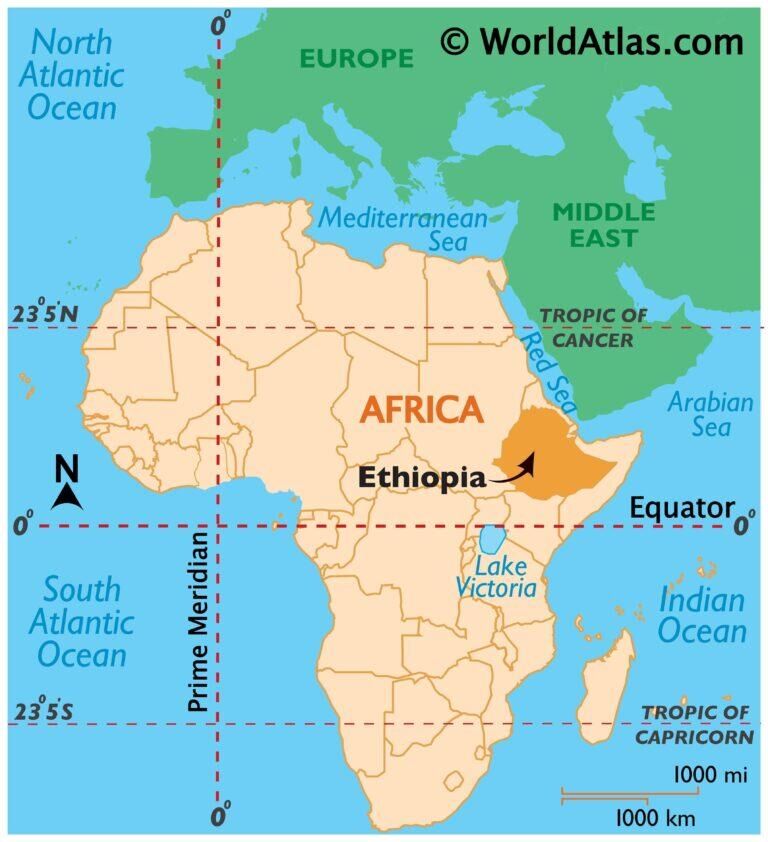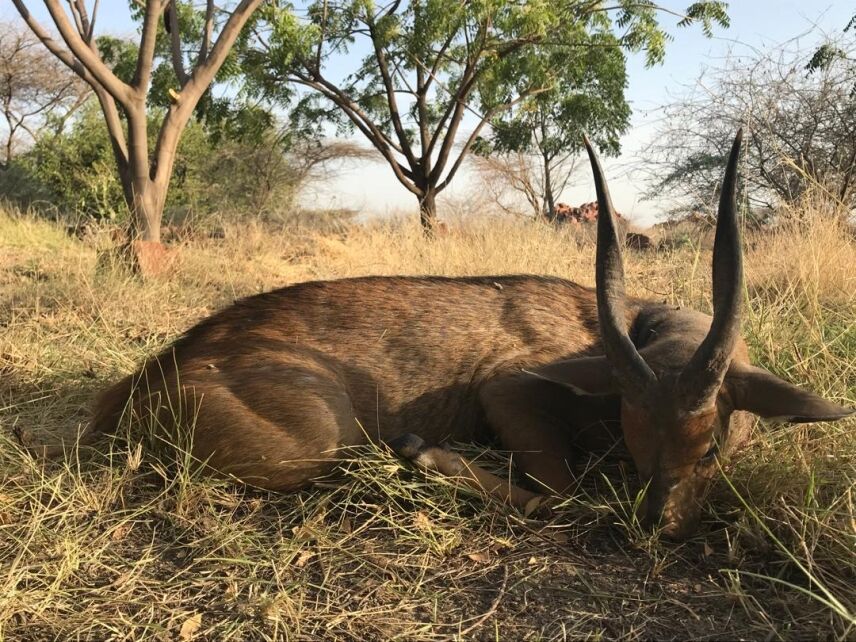Situated in the Horn of Africa, Ethiopia is a landlocked country, bordered by Kenya, Sudan, South Sudan, Eritrea, Somalia, and Djibouti. With a surface area approximately 1.6 times the size of Texas, Ethiopia is strategically located to be a major player in the region.
[DYNAMIC-BLOGTABLEOFCONTENT]

Ethiopia At a Glance
- Size: 426,400 square miles (1,104,300 square kilometers)
- Population: 135,5 million
- Official Languages: While English is widely used in education, there are five official working languages, namely Afar, Amharic, Oromo, Somali, and Tigrinya
- Currency: Ethiopian Birr (ETB)
- Government: Ethiopia is a federal parliamentary republic with both a President (ceremonial Head of State) and a Prime Minister (Head of Government)
- Capital City: Addis Ababa
Climate & Topography
Climate
Ethiopia’s climate ranges from cool and wet in the highlands to hot and arid in the lowlands, with distinct wet and dry seasons.
Ethiopia is home to a diverse range of topography and altitudes, resulting in the country being divided into five distinct climatic zones:
- Bereha (Hot Arid Zone): This region is found in the desert lowland (less than 1,600 feet) and sees less than 15 inches of rain annually. Temperatures range between 82-93°F or higher.
- Kolla (Warm Semi-Arid Zone): This zone features warm to hot conditions (68-86°F) with annual rainfall ranging from 15 to 63 inches.
- Woina Dega (Temperate Highlands): This zone is found between 4,900 to 8,200 feet, with an annual rainfall of between 47 inches to 94 inches in the southern region.
- Dega: The Highlands are known as being cool and humid, with average temperatures in the region being fairly mild, ranging between 50-60°F. The annual mean rainfall for the region ranges between 39-78 inches.
- Wurch Zone: This zone falls above 10,500 feet and is known for its cold temperatures, with a mean temperature of less than 10°F. The annual rainfall of the region is less than 31 inches.
In terms of rainfall, the wettest season is from June to September when the country receives the most rain. October to January is the driest season, while February to May experiences light rains across the region.
Why Choose to Go Hunting in Ethiopia?
When it comes to unique hunting safaris, Ethiopia is leading the way, ticking all the boxes in terms of ensuring authentic African hunting adventures and appealing to select hunters looking for a challenging and unusual hunting experience. Check out some of the reasons why this country is growing in popularity as a hunting destination:
- Authentic African Experience: Much hunting in Ethiopia occurs in open areas, not fenced or semi-fenced concessions, ensuring a more authentic African hunt.
- Diverse Array of Unusual Species: Ethiopia is home to some unusual and sought-after species, such as the Abyssinian bushbuck, Salt’s Dik-Dik, as well as numerous Old-World monkeys.
- Adventure in Rugged Terrain: From the Ethiopian highlands to the remote valleys and desolate hunting regions, hunters can experience the challenge of an authentic Ethiopian hunting adventure.
- Access All Year Around: Ethiopia safari hunts take place throughout the year, although the best time to enjoy a hunting safari is from October to June, as this falls outside of the wet season.
- Exclusivity: Hunting in Ethiopia is not a discount hunting destination, with few hunters annually visiting this unique destination. This allows those hunters embarking on an Ethiopian safari to this African gem a serene and exclusive hunting experience.
- Scenic Landscapes: Enjoy your Ethiopian hunting safari with a wide array of scenic landscapes forming the backdrop of an unforgettable hunt.

Traveling to Ethiopia
- Traveling to Ethiopia is quite straightforward, with Ethiopian Airlines offering direct flights from various cities within the United States, including Boston, Washington, Atlanta, Chicago, and Minneapolis, among others.
- Direct flights from cities in the US to Addis Ababa take between 12-15 hours, depending on the departure city.
- Ethiopian Airlines offers direct flights from various European cities, including Rome, Frankfurt, and Paris.
- Most travelers from European countries, as well as the United States, require a visa for Ethiopia.
- Ethiopia’s e-Visa provides travelers with an easy option to obtain a visa before departure.
- The cost for a single-entry 30-day tourist visa is US$62. Visitors need to enter through Addis Ababa Bole International Airport.
- The passport needs to be valid for at least 6 months after entering the country.
Medical Requirements
To enter Ethiopia, certain vaccinations are required:
- Yellow Fever Vaccination: Proof of the Yellow Fever Vaccination is required should you arrive from a high-risk country or transit through an airport of a high-risk country. While not required to enter the country for travelers from the US or Europe, it is recommended for travelers older than 9 months.
- Ensure that all routine inoculations are updated: MMR, Chickenpox, Polio, Tetanus, Diphtheria, Pertussis, etc.
- Ethiopia is a known Malaria area. Start Malaria medication before you arrive in the country
- Other recommended vaccinations include:
- Covid-19 Vaccination
- Hepatitis A
- Hepatitis B
- Typhoid
- Meningitis
Ethiopia is a known malaria area, especially in low-lying areas. Additional measures are suggested to combat mosquitoes. These include using an insect repellent containing DEET, wearing long-sleeved shirts and long trousers, and sleeping under mosquito nets.
Popular Regions when Hunting in Ethiopia:
Regions for Ethiopia hunting safaris can be divided into two main areas, namely the Highland hunting and Lowland hunting regions, each targeting different species on the Ethiopian safari.
Highland Hunting Regions
- This region includes the Bale and Amhar mountain ranges, concentrating on endemic highland species, making it a unique trophy.
- Popular species hunted in this area include the Mountain Nyala, Menelik’s Bushbuck, Bushpig, Colobus Monkey, and Leopard.
Lowland Hunting Regions
- The Western and Southwestern areas of Ethiopia comprise habitats including savanna and woodlands.
- The Lowlands include the areas of the Bale Zone, as well as the Omo Valley, where species such as the Greater Kudu, Defassa Waterbuck, and other varieties of African plains game species can be hunted.
- Towards the northeast of the country lies the Danakil Depression and the Afar region, renowned for stunning and striking African plains game species such as the Beisa Oryx, Lesser Kudu, Salt’s Dik-dik, the Gerenuk, as well as the Abyssinian Bushbuck.
Species to Target for Hunting in Ethiopia
Ethiopia is truly a niche destination, offering hunting collectors a rare and unique array of species to target:
The Gelada
This species of Old-World Monkey is only found in the Ethiopian Highlands, ensuring its sought-after ranking by hunters. The Gelada (Theropithecus gelada) is regarded as challenging to hunt, as its alert and wary nature makes approaching this primate undetected quite a test of a hunter’s skillset.
Hamadryas Baboon
Another species of the Old-World Monkeys, this primate is found in Ethiopia as well as regions of Djibouti, Eritrea, Saudi Arabia, Somalia, Sudan, and Yemen.
Salt’s Dik-Dik
The Salt’s Dik-Dik is one of five subspecies of Dik-Dik on the African continent and remains a challenge to hunt due to its wary nature and its chosen habitat of dense undergrowth, which makes it a challenge to spot and stalk undetected.
Ayssinian Bushbuck
This agile bushbuck is a challenge to target when game hunting in Ethiopia, favoring dense thickets and forests where it can hide from predators. The Abyssinian bushbuck (Tragelaphus scriptus decula) is often found in small groups or alone, is an agile and alert target, difficult to stalk, and a notable trophy from Ethiopian safaris.
Mountain Nyala
The Mountain Nyala is endemic to Ethiopia, and hunts are often conducted in the Bale and Ahmar mountain ranges. This sought-after trophy is often on the list for big game American hunters looking for a unique and rare trophy.
Tourist Activities in Ethiopia
While Ethiopia may not be your average family vacation spot, the country has some lovely and unique tourist attractions to visit and enjoy. It offers travelers a variety of heritage and cultural, outdoor and natural beauty sites, seamlessly blending these features for a memorable Ethiopian safari experience:
- Lalibela (Rock-Hewn Churches): Located in Ethiopia’s northern Amhara region, this UNESCO World Heritage Site is often referred to as “The New Jerusalem.” This site is one of the country’s holiest areas, with churches carved directly into the rock.
- Harar Jugol: This old city is considered the fourth holiest in Islam and is a UNESCO World Heritage Site. Renowned for its teeny tiny, curving streets and bustling markets, this holy town is well worth a visit.
- The Merkato in Addis Ababa: This is Africa’s largest open-air market and is renowned for its authentic cultural style, lively shopping, and defining cultural experience. Don’t miss it!
- Gondar: Located in northern Ethiopia, the Gondar region is known for its striking 17th-century castles, as well as the Debre Birhan Selassie Church.
- Lake Tana: Located in the Amhara region of northern Ethiopia, Lake Tana is the country’s largest lake and the starting point of the Blue Nile.
- The Blue Nile Falls: These are often referred to by locals as Tis Abay (“great smoke”). They are situated near the town of Bahir Dar, with a height of around 138 ft.
- Bale Mountain National Park: This national park is situated about 250 miles from the nation’s capital, Addis Ababa, and is well worth a visit, boasting a large array of animal and bird life in this magnificent park.
Enjoy an Unforgettable Adventure Hunting in Ethiopia
While Ethiopia remains the pinnacle of African hunts for certain American hunters and collectors, it is not your everyday hunting adventure. Fewer hunters in the region means a more intimate and tailored experience on your Ethiopia hunting safari, with unusual and rare species adding to a trophy room back home. Don’t miss the chance to discover what makes hunting in Ethiopia so unique!
